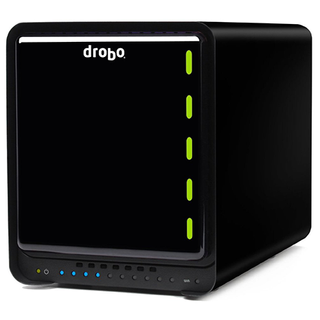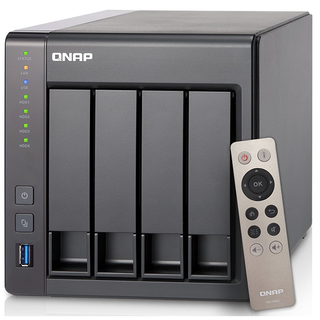Thecus N4810 Review
Why you can trust Tom's Hardware
SMB / CIFS Performance
Comparison Products
We chose a selection of four and five-bay NAS solutions based on popularity, availability, and pricing to compare to the Thecus N4810.
Testing Considerations
We tested all the systems with 4TB Seagate NAS HDDs in a RAID 5 array over a 1-gigabit Ethernet connection. We use a modified enterprise server to connect to the devices over a dedicated network for most of our tests. Ten servers work in concert to perform the multiclient test. Each server utilizes two Hot Lava 6-port network cards to push a 120-client office workload.
We ran the Thecus N4810 with an EXT4 file system. It also supports XFS and BRTFS.
Sequential Read



Most of the products in this category deliver the maximum sequential read performance possible over a single gigabit Ethernet connection. Performance really goes back to the type of data transferred. With a large file, it's possible to achieve a transfer at 115 MB/s to your PC. The Thecus N4810 with a quad-core processor operates at the upper end of the sequential read performance spectrum.
Sequential Write



Modern NAS units can write sequential data with the same level of performance as read data. A single large file transfer moves to the NAS from your PC at over 110 MB/s. Just like sequential reads, the sequential write performance is block size dependent. The protocol breaks large blocks down to Ethernet packet sizes, but the queue depth increases as the data stacks up during the transfer. Latency can disrupt the queue, so consistent performance helps to increase the flow. Buffers that act as a cache, both in the NAS and on the hard disk drives, help to smooth the incoming data traffic.
Sequential Mixed Workload Sweep




A mixed read/write workload taxes both the storage media and the system buffers. Every system uses the same Seagate 4TB NAS HDDs, network, and host system, which allows us to isolate NAS performance as the only variable. The Thecus N4810 performs well while reading and writing data at the same time, but we expected higher performance from the quad-core processor paired with 4GB of system memory. If you need to transfer data to and from the system, it will take less time to wait for one operation to complete and then start the other; performing both operations simultaneously cuts the bandwidth in half.
Random Read



Random data poses a different set of problems. This workload typically consists of small file transfers over the network. It requires a high-speed processor to keep pace with the data. We measure performance in IOPS. Most users don't transfer a lot of random data to the NAS unless they run applications from the system. Modern NAS are powerful enough to host virtual machines, which is the ultimate random data test because the NAS acts as the host's hard drive. Windows optimizes Hyper-V systems for 4KB data, but VMWare optimizes for 8KB transfers.
System cache plays a big role in random read performance. The QNAP TS-451A scales well as the queue depth increases, which is the result of a strong read cache. The Drobo 5N consistently falls to the bottom of the performance chart due to its less efficient processor and the overhead from Drobo's proprietary BeyondRAID software.
The Thecus N4810 performs between those two systems and is comparable to many of the other products in the test pool.
Random Write



The systems rely heavily on system and disk cache to absorb incoming random data. In this test, we use a steady stream of random data going to the NAS, in the next section we'll examine burst performance.
The Thecus N4810 performs very well during the random write test. The quad-core processor paired with 4GB of system memory allows the system to accept the data at a high rate and continue to provide optimal performance.
Random Mixed Workload Sweep




The mixed workload sweep test shows how the systems bog down with any workload other than 100% random writes. Most of your applications running on the NAS will be read-centric in nature. Consumer applications are roughly 80% read, and workstation-level applications move the needle to a 70% read workload.
Server Workloads










All the systems deliver a set amount of IOPS, and if the workload intensifies the latency increases. The QNAP TS-451A is the sole exception. Many of the workloads will scale well due to the read cache, which allows system performance to scale as the workload increases. Most of these workloads would run over iSCSI, but we still like to measure performance without setting up the complicated iSCSI connection.
Client Workloads
The client workloads are simple file transfers over the network using the SMB/CIFS protocol. This workload is indicative of data transfers to the NAS through a Windows folder, such as \\name_of_nas\folder_name. The N4810's performance lines up with the results of the synthetic tests we already performed.
Multiclient Office Workloads


Any workload coming from 120 different sources, even 100-percent sequential data, becomes randomized due to the sheer amount of data involved. This test uses 120 systems to run a trace file consisting of files from Microsoft Office applications such as Word, Excel, and PowerPoint. Our workload generator offsets the trace data, and each client system has its own data stream from a dedicated folder. We look for the number of concurrent client connections that can work on a system before the added latency decreases performance.
The Thecus N4810 peaks at sixteen clients before performance decreases.
Stay on the Cutting Edge
Join the experts who read Tom's Hardware for the inside track on enthusiast PC tech news — and have for over 25 years. We'll send breaking news and in-depth reviews of CPUs, GPUs, AI, maker hardware and more straight to your inbox.



